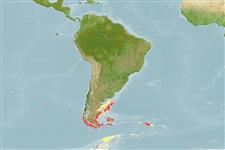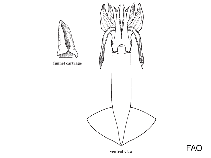Martialia hyadesi Rochebrune & Mabille, 1889
Sevenstar flying squid| Native range | All suitable habitat | Point map | Year 2050 |

|
| This map was computer-generated and has not yet been reviewed. |
| Martialia hyadesi AquaMaps Data sources: GBIF OBIS |
Google image | No image available for this species;
drawing shows typical species in Ommastrephidae.
Classification / Names Common names | Synonyms | CoL | ITIS | WoRMS
Cephalopoda | Oegopsida | Ommastrephidae | Todarodinae
Environment: milieu / climate zone / depth range / distribution range Ecology
Pelagic; depth range 0 - 50 m (Ref. 101277). Temperate, preferred 13°C (Ref. 107945); 40°S - 65°S, 110°W - 17°W (Ref. 275)
Distribution Countries | FAO areas | Ecosystems | Occurrences | Introductions
Southern Ocean.
Length at first maturity / Size / Weight / Age
Maturity: Lm ? range ? - ? cm Max length : 40.0 cm ML male/unsexed; (Ref. 275)
Life cycle and mating behavior Maturity | Reproduction | Spawning | Eggs | Fecundity | Larvae
Main reference
References | Coordinator | Collaborators
Wood, J.B. and C.L. Day. 1998. (Ref. 3722)
IUCN Red List Status
(Ref. 130435: Version 2024-2)
CITES status (Ref. 108899)
CMS (Ref. 116361)
Threat to humans
Human uses
Fisheries: commercial
FAO - Fisheries: landings | FishSource | Sea Around Us
Tools
More information
Max. ages / sizes
Length-weight rel.
Length-length rel.
Length-frequencies
Mass conversion
Abundance
Internet sources
BHL | BOLD Systems | CISTI | DiscoverLife | FAO(Fisheries: ; publication : search) | Fishipedia | GenBank (genome, nucleotide) | GloBI | Gomexsi | Google Books | Google Scholar | Google | PubMed | Tree of Life | Wikipedia (Go, Search) | Zoological Record



